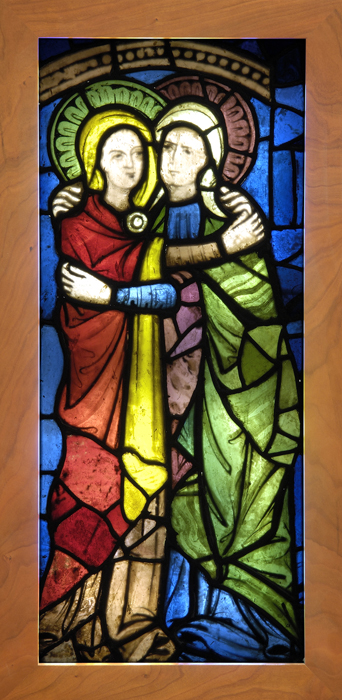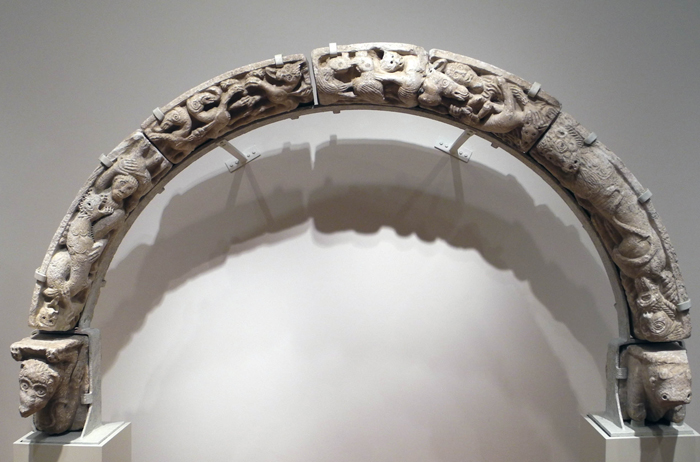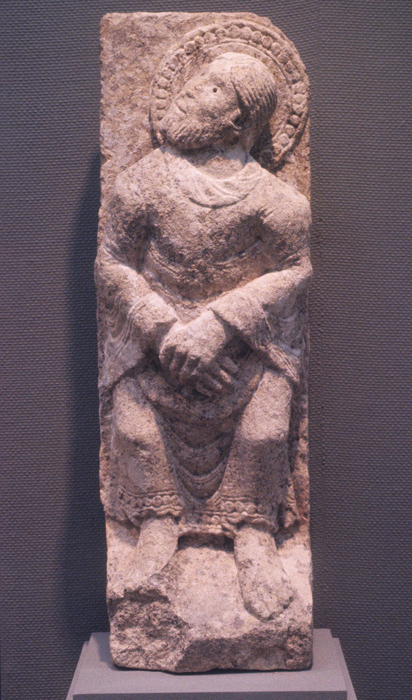Background
The medieval period in Europe (also known as the Middle Ages) is generally understood as stretching from the fall of the Roman Empire in 476 to the start of the Renaissance around 1400. Art production in the period included architectural and free-standing sculpture, stained glass, manuscripts, and painting (fresco [pigment mixed with wet plaster] and tempera [pigment mixed with egg, on panel]). Much of the surviving art from the period relates to Christian church building and religious life. In other words, the artworks served specific functions.
How do you look at medieval works?
Look at the material and its condition.
- What condition is the work in?
- Is it worn down from exposure to the weather?
- Do you see any traces of polychrome (colors)? Many works were originally painted, but the colors may have worn off over time.
- Is the work a complete work or is it a fragment?
- Has anything been restored? How can you tell?
- Is the person young or old? Male or female? Individualized or generic? Naturalistic or exaggerated? Expressive or not? A local or historic person, religious being, mythological character, or allegorical figure?
- Can you identify the figure? Who is it? How can you tell?
- What attributes (visual characteristics) make the individual recognizable?
- Where else have you seen the figure, if at all? Where would you expect to see him or her? Why do you think this?
- If there are multiple beings, how do they interact with each other? What do you think is the significance of this interaction, or lack thereof?
- If the figures were originally installed in an architectural setting, how do you think they interacted with the architecture? Why do you think they were specifically chosen for the particular structure?
- Does the work depict a narrative, or do you think the work was part of a larger narrative? If so, what story is illustrated? Is it religious, mythological, or literary?
- How is the narrative visualized? How does it unfold?
- What message(s) do you think the viewer was supposed to interpret from the narrative? What moral and/or spiritual lesson(s) do you think the viewer was supposed to learn?
- Do you think different viewers would have understood the story and its lesson(s) the same way or differently? Why do you think this?
Look for ornamentation (decorative elements and embellishments).
- Is the ornamentation design geometric or organic? Dynamic or static?
- What is the relation between it and the overall form and function of the work?
- If there are also figures in the work, what is the relation between the ornamentation and the figures? How does the ornamentation draw attention to the figure, or not, and vice versa?
- What do you think is the significance of the ornamentation? What sort of meaning do you think it conveyed? Why do you think this?
Look like you lived in the medieval period.
- How was the work originally displayed or used? What was its original setting and context?
- If the back of a sculpture is flat, it may have been attached to an architectural structure.
- If the back of a sculpture is hollowed out, it may have been part of an altarpiece.
- If the sculpture is carved all around, it was likely free-standing.
- Who would have seen and/or interacted with the work?
- From what position or angle would the work have been seen? What do you think the lighting would have been like?
- Do you see any evidence of exchange between different religious groups, cities, and/or cultures in the work?
Look like a 21st-century viewer.
- How do you think your interaction with and experience of the work in the museum compares to people’s interactions with and experiences of the work in the medieval period?
Look at the work’s history and provenance.
- Where did the work originally come from? Was it created for a public or private space? Why do you think this?
- Where was the work made? Who made it—an individual or a workshop?
- Who commissioned the work, and why?
- Is the work a complete work or is it a fragment? If it is a fragment, what is missing? How and/or why was the original work partially destroyed?
- How did it get to the Nasher Museum of Art at Duke University? Where else has the work been? Who else has owned it?
- If we don’t know where the object came from, how could you go about finding out its provenance?
Want to know more?
Related “How Do You Look?” Guides
Collecting, Collection, Collector
Sculpture
Works in the Nasher’s Collection
Exhibitions at the Nasher Museum
The Collection Galleries (ongoing)
Sacred Beauty: Medieval and Renaissance Illuminated Manuscripts from the Collection of Robert J. Parsons (Jan. 19 – May 10, 2009)
Bibliography
Ames-Lewis. Francis. Tuscan Marble Carving, 1250-1350: Sculpture and Civic Pride. Aldershot: Ashgate Publishing, 1997.
Bagnoli, Martina, and Kathryn Gerry. The Medieval World. Baltimore: The Walters Art Museum, 2011.
Bartlett, Robert, ed. The Medieval World Complete. London: Thames & Hudson, 2010.
Benton, Janetta Rebold. Art of the Middle Ages. London: Thames & Hudson, 2002.
Bruzelius, Caroline, and Jill Meredith. The Brummer Collection of Medieval Art. Durham: Duke University Press, in association with the Duke University Museum of Art, 1991.
Cahn, Walter, and Linda Seidel. Romanesque Sculpture in American Collections. New York: Burt Franklin & Co., Inc., 1979.
Cardarelli, Sandra, Emily Jane Anderson, and John Richards, eds. Art and Identity: Visual Culture, Politics and Religion in the Middle Ages and the Renaissance. Newcastle upon Tyne: Cambridge Scholars, 2012.
Cassidy, Brendan. Politics, Civic Ideals and Sculpture in Italy, c. 1240-1400. London: Harvey Miller, 2007.
Castelnuovo-Tedesco, Lisbeth, and Jack Soultanian. Italian Medieval Sculpture in the Metropolitan Museum of Art and the Cloisters. New York: Metropolitan Museum of Art, 2010.
Frankl, Paul. Gothic Architecture. New Haven: Yale University Press, 2000.
Gertsman, Elina. Worlds Within: Opening the Medieval Shrine Madonna. University Park, P.A.: The Pennsylvania State University Press, 2015.
Hayward, Jane. English and French Medieval Stained Glass in the Collection of the Metropolitan Museum of Art. New York: Harvey Miller Publishers, 2003.
Hourihane, Colum, ed. Looking Beyond: Visions, Dreams, and Insights in Medieval Art & History. University Park: Penn State University Press, 2010.
Little, Charles T., ed. Set in Stone: The Face in Medieval Sculpture. New Haven: Yale University Press, 2006.
Male, Emile. The Gothic Image: Religious Art in France in the Thirteenth Century. New York: Harper and Row, 1972.
Male, Emile. Religious Art in France: The Late Middle Ages. Princeton: Princeton University Press, 1986.
Male, Emile. Religious Art in France: The Twelfth Century. Princeton: Princeton University Press, 1978.
Moeller III, Robert C. Sculpture and Decorative Art: A Loan Exhibition of Selected Art Works from the Brummer Collection of Duke University. Exh. cat. Raleigh: North Carolina Museum of Art, 1967.
Moskowitz, Anita. Italian Gothic Sculpture, 1250-1400. Cambridge: Cambridge University Press, 2001.
Olson, Vibeke, ed. Working with Limestone: The Science, Technology and Art of Medieval Limestone Monuments. Aldershot: Ashgate, 2011.
Penny, Nicholas. The Materials of Sculpture. New Haven: Yale University Press, 1993.
Pope-Hennessy, John. Italian Gothic Sculpture. London: Phaidon Press, 1996.
Rudolph, Conrad, ed. A Companion to Medieval Art: Romanesque and Gothic in Northern Europe. Malden: Blackwell Publishing Ltd., 2010.
Saulander, Willibald. Gothic Sculpture in France, 1140-1270. London: Thames and Hudson, 1972.
Schapiro, Meyer. Romanesque Architectural Sculpture. Chicago: University of Chicago Press, 2006.
Snyder, James. Medieval Art: Painting, Sculpture, Architecture, 4th-14th Century. New York: H. N. Abrams, 1989.
Taubert, Johannes. Polychrome Sculpture: Meaning, Form, Conservation. Los Angeles: Getty Conservation Institute, 2015.
Trusted, Marjorie, ed. The Making of Sculpture: The Materials and Techniques of European Sculpture. London: V and A Publications, 2007.
White, John. Art and Architecture in Italy. New Haven: Yale University Press, 1993.
Williamson, Paul. Medieval and Renaissance Stained Glass in the Victoria and Albert Museum. London: V & A Publications, 2003.
Williamson, Paul. Northern Gothic Sculpture, 1200-1450. London: Victoria and Albert Museum, 1988.
Wixom, William D. Medieval Sculpture at the Cloisters. New York: Metropolitan Museum of Art, 1999.
Wixom, William D. Mirror of the Medieval World. New York: Metropolitan Museum of Art, 1999.




